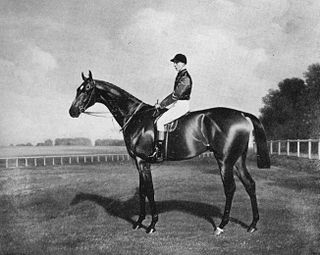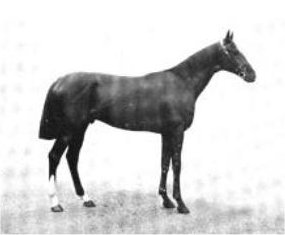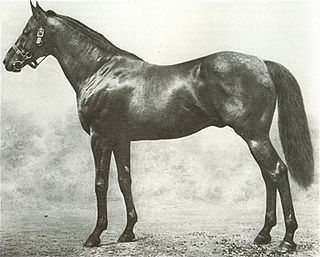
Bend Or (1877–1903) was a British Thoroughbred racehorse who won the 1880 Epsom Derby. His regular jockey Fred Archer, winner of thirteen consecutive British jockey titles, said Bend Or was probably the greatest horse he had ever ridden.

Volodyovski (1898–1917) was a British Thoroughbred racehorse and sire. In a career which lasted from 1900 to 1902, he ran twenty-six times and won seven races. After being one of the leading two-year-olds of 1900, he went on to win The Derby in 1901. His subsequent form was disappointing and he was retired to stud after failing to win in eleven starts as a four-year-old. He made no impact as a stallion.

Diamond Jubilee was a British-bred and British-trained Thoroughbred race horse and sire. In a career which lasted from June 1899 until October 1901 he ran sixteen times and won six races.

Sainfoin was a British Thoroughbred racehorse that was the winner of the 1890 Epsom Derby and was the sire of Rock Sand, the tenth winner of the Triple Crown in 1903.
Manna (1922–1939) was a British Thoroughbred racehorse and sire. In a career which lasted from summer 1924 until September 1925, Manna ran eight times, winning four races. As a three-year-old in 1925 he won the 2000 Guineas at Newmarket and The Derby by a record margin of eight lengths. Manna was retired after breaking down in his bid to win the Triple Crown in the St. Leger at Doncaster. He later had a successful career at stud.
Orby (1904–1918) was an Anglo-Irish Thoroughbred racehorse and sire. In a racing career which lasted from 1906 to 1907 he ran seven times and won four races. In 1907 he became the first Irish-trained horse, and the third owned by an American, to win The Derby. In the same year, he became the first horse to complete the Epsom Derby-Irish Derby double, but his racing career was ended by training problems after one further race. He went on to become a successful breeding stallion.

Jeddah (1895–1909) was a British Thoroughbred racehorse and sire. In a career that lasted from 1897 to 1899 he ran nine times and won three races. In the summer of 1898 he became the first horse to win The Derby at odds of 100/1, and followed up by winning the Prince of Wales's Stakes at Royal Ascot. He was retired to stud after a single, unsuccessful race in 1899, but had serious fertility problems and made no impact as a stallion.
Galtee More (1894–1917) was an Irish-bred, British-trained Thoroughbred racehorse and sire. In a career that lasted from 1896 to 1897 he ran thirteen times and won eleven races. As a three-year-old in 1897 he became the seventh horse to win the English Triple Crown by winning the 2000 Guineas at Newmarket, the Derby at Epsom and the St Leger at Doncaster. At the end of the season he was sold to the Russian government and went on to have a successful stud career in Russia and Germany. He died following an accident in 1917.

Common (1888–1912) was a British Thoroughbred racehorse and sire. In a career that lasted from May to September 1891 he ran five times and won four races. He became the fifth, and the most lighty-raced horse to win the English Triple Crown by winning the 2000 Guineas at Newmarket, the Derby at Epsom and the St Leger at Doncaster.

Sir Visto (1892–1914) was a British Thoroughbred racehorse and sire. In a career that lasted from 1894 to 1896 he ran thirteen times and won three races. As a three-year-old in the 1895 he won both The Derby and the St Leger at Doncaster. He failed to win in six subsequent races and was retired to stud at the end of the 1896 season.

Sir Hugo (1889–1910) was a British Thoroughbred racehorse and sire. In a career that lasted from 1891 to 1894 he ran eight times and won three races. As a three-year-old in 1892 he won The Derby at odds of 40/1. He was a consistent performer in top class races, but certainly inferior to his contemporaries Orme and La Fleche.

Donovan (1886–1905) was a British Thoroughbred racehorse and sire. In a career that lasted from 1888 to 1889 he ran twenty-one times and won eighteen races. He was the leading British two-year-old of 1888 when he won eleven of his thirteen starts. At three Donovan won The Derby and the St Leger: he failed to win the English Triple Crown owing to a narrow and probably unlucky defeat in the 2000 Guineas. He set a world record by earning a total of £55,443 in win prize money. Donovan was a modest success as a stallion. He died after being injured in an accident in 1905.

Merry Hampton was a British Thoroughbred racehorse and sire. In a career that lasted from 1887 to 1888 he ran four times and won once in a career that was restricted by injuries and training difficulties. His sole victory came on his racecourse debut when he won the 1887 Epsom Derby as an 11/1 "dark horse". He never won again but did finish second in the St. Leger Stakes at Doncaster. He was retired to stud after a single start as a four-year-old in which he aggravated a chronic leg injury.

Ayrshire (1885–1910) was a British Thoroughbred racehorse and sire. In a career that lasted from 1887 to 1889 he ran sixteen times and won eleven races. After winning five races as a two-year-old he became the leading British three-year-old colt of 1888 when he won the 2000 Guineas at Newmarket and the Derby at Epsom. He failed in his bid to win the English Triple Crown when beaten in the St Leger at Doncaster but returned in 1889 for a successful campaign which included a win in the Eclipse Stakes at Sandown. He was retired to stud at the end of the year and had a modestly successful career as a stallion. He died in 1910.

Harvester (1881–1906) was a British Thoroughbred racehorse and sire. In a career that lasted from 1883 to 1884 he ran thirteen times and won five races. In 1884 he was involved in the second, and most recent dead heat in the history of The Derby. At the end of his racing career, Harvester was sold and exported to stand as a stallion in Austria. He died in 1906 in Hungary.

Silvio (1874–1890) was a British Thoroughbred racehorse and sire. In a career that lasted from 1874 to 1877 he ran eight times and won three races. In 1877 he won The Derby and the St Leger. At the end of the 1877 season he was retired to stud where he had success both in England and France.

Kisber (1873–1895) was a Hungarian-bred Thoroughbred racehorse and sire. In a career that lasted from 1875 to 1876 he ran seven times and won three races. In the summer of 1876 he became the third of six horses to win both The Derby and the Grand Prix de Paris. He was the second foreign-bred horse, after Gladiateur in 1865, to win the Derby: he remains the only Hungarian-bred horse to do so. At the end of the season he was retired to stud.

Blair Athol (1861–1882) was a British Thoroughbred racehorse and sire. In a career that lasted little more than three months in the summer and autumn of 1864, he ran seven times and won five races including one walk-over. His wins included The Derby and the St Leger. Despite the brevity of his racing career, he was regarded by contemporary experts as one of the best British racehorses of his era and arguably the greatest horse ever trained in the North of England. He went on to become a highly successful stallion, siring the winners of many races.

Pretender (1866–1878) was a British Thoroughbred racehorse and sire. After showing promise as a two-year-old in 1868 he improved to become a top class performer in the early part of the following year. He won the 2000 Guineas at Newmarket and The Derby. Pretender was the last horse trained in the North of England to win the Derby. He failed to complete the Triple Crown when he was beaten in the St Leger at Doncaster. Pretender’s form subsequently deteriorated and he failed to record any significant wins despite staying in training for two more seasons. He made no impression as a stallion.

Thormanby (1857–1875) was a British Thoroughbred racehorse and sire. In a career that lasted from May 1859 to July 1861, he ran twenty-four times and won fourteen races. He was regarded by experts as one of the outstanding horses of his era.


























